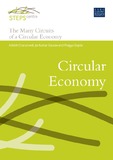The Many Circuits of a Circular Economy
| dc.contributor.author | Chaturvedi, Ashish | |
| dc.contributor.author | Gaurav, Jai Kumar | |
| dc.contributor.author | Gupta, Pragya | |
| dc.coverage.spatial | India | en |
| dc.date.accessioned | 2017-11-23T16:09:42Z | |
| dc.date.available | 2017-11-23T16:09:42Z | |
| dc.date.issued | 2017-11-16 | |
| dc.identifier.citation | Chaturvedi, A., Gaurav, J. K. and Gupta, P. (2017) The Many Circuits of a Circular Economy, STEPS Working Paper 94, Brighton: STEPS Centre | en |
| dc.identifier.uri | https://opendocs.ids.ac.uk/opendocs/handle/20.500.12413/13356 | |
| dc.description.abstract | Rapid urbanisation in India has led to the development of large urban agglomerations. These urban agglomerations, with dense concentration of population and economic activity, cause significant environmental stresses. The drawing up of resources and the generation of discharges are distributed in spaces within and beyond city boundaries. This inflow and outflow of resources suggests that cities are open systems with resource flows flowing in and out of city boundaries. A critical characteristic of such flows is that they are embedded in contestations in both material and discursive arenas. Actors with several, and conflicting interests, are affected by, and involved in managing, these flows of resources. The governance of these flows in the presence of such diverse and conflicting interests is critical to ensure that the most vulnerable actors involved in these flows have equitable access to resources as well as are not over-burdened by the degradation due to such flows in an out of cities. Over the last few years, the idea of a circular economy, driven by narratives of material scarcity and enhanced resource efficiency, is gaining traction around the globe. The focus of the existing literature on circular economy has largely been techno-managerial with a large emphasis on the role of big business in solving the problem. However, a close look at these flows of resources in India shows that a large part of these flows of resources happen outside the formal economy. Also, the focus of the existing literature on techno-managerial solutions ignores the multiple contestations in the material and discursive arenas. We believe that there is a limited focus on the politics of these flows in this literature. We focus on the case of closing material cycles in urban areas. We develop a conceptual framework that combines circular economy models and situates them in the variable power geometries of actors involved in these material flows in urban areas and beyond. With this conceptual framework, we examine the case of flow of materials in India (with a focus on Delhi). At the same time, we examine the impact of a focus on techno-managerial solutions on the vulnerable and marginal communities in urban areas. | en |
| dc.language.iso | en | en |
| dc.publisher | ESRC STEPS Centre | en |
| dc.relation.ispartofseries | STEPS Working Papers;94 | |
| dc.rights | Users are welcome to copy, distribute, display, translate or perform this work without written permission subject to the conditions set out in the Creative Commons licence. For any reuse or distribution, you must make clear to others the licence terms of this work. If you use the work, we ask that you reference the STEPS Centre website (www.steps-centre.org) and send a copy of the work or a link to its use online to the following address for our archive: STEPS Centre, University of Sussex, Brighton BN1 9RE, UK (steps-centre@ids.ac.uk). | en |
| dc.rights.uri | http://creativecommons.org/licenses/by-nc-nd/3.0/ | en |
| dc.subject | Climate and Environment | en |
| dc.subject | Environment | en |
| dc.subject | Industrial Development | en |
| dc.subject | Urban Development | en |
| dc.title | The Many Circuits of a Circular Economy | en |
| dc.type | Series paper (non-IDS) | en |
| dc.rights.holder | ESRC STEPS Centre | en |
| rioxxterms.funder | Default funder | en |
| rioxxterms.identifier.project | STEPS Centre | en |
| rioxxterms.version | VoR | en |
| rioxxterms.funder.project | 7360ec74-14f4-4420-af2a-8ca314d07ffe | en |
Files in this item
This item appears in the following Collection(s)
-
ESRC STEPS Centre [225]
Except where otherwise noted, this item's license is described as Users are welcome to copy, distribute, display, translate or perform this work without written
permission subject to the conditions set out in the Creative Commons licence. For any reuse or
distribution, you must make clear to others the licence terms of this work. If you use the work, we ask
that you reference the STEPS Centre website (www.steps-centre.org) and send a copy of the work or a
link to its use online to the following address for our archive: STEPS Centre, University of Sussex,
Brighton BN1 9RE, UK (steps-centre@ids.ac.uk).


